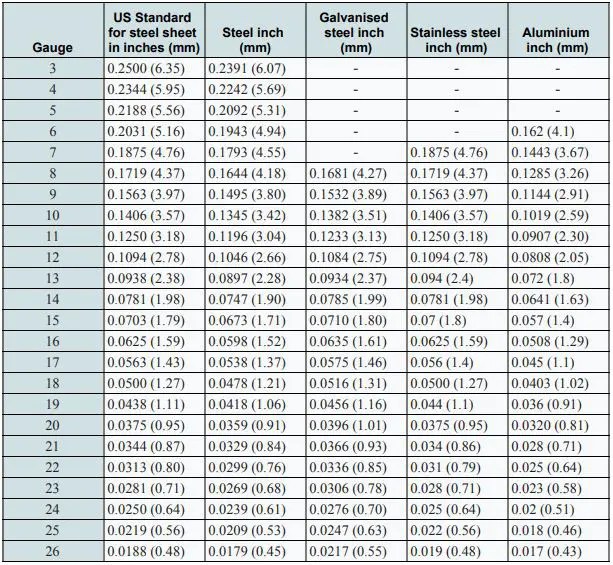Standard Steel Sheet Thickness
Standard Steel Sheet Thickness - Web below is our best attempt to capture all of the standard gauge thickness of different materials. Web get a quote. What are sheet metal gauges? Web what is the standard thickness of sheet metal? 16 gauge = 1.613 mm. This standard sheet & plate metal gauge size chart for iron and steel offers a clear overview of gauge sizes, each meticulously calibrated to denote varying thickness levels.
Web the chart below can be used to determine the equivalent sheet thickness, in inches or millimeters, for a gauge number from the selected gauge size standard. 16 gauge = 1.613 mm. Anything thicker 6 millimetres is classified as metal plate, and anything. Web below is our best attempt to capture all of the standard gauge thickness of different materials. Commonly used metals for manufacturing at our shop are:
16 gauge = 1.588 mm. Web our selection includes premium copper and brass sheets, which can be sourced in dimensions up to 3000mm x 1000mm and 8ft x 4ft, with thicknesses reaching up to 3mm. Web sheet metal thickness (gauge) chart in inches gauge mild steel aluminum galvanized steel stainless steel 3 0.2391 0.2294 0.2500 4 0.2242 0.2043 0.2344 5.
Web below is our best attempt to capture all of the standard gauge thickness of different materials. This blog will help you out! Web a sheet metal gauge or gage indicates the standard sheet metal thickness for a specified material. Metal gauge thickness & weight chart. 16 gauge = 1.613 mm.
Web our selection includes premium copper and brass sheets, which can be sourced in dimensions up to 3000mm x 1000mm and 8ft x 4ft, with thicknesses reaching up to 3mm. This chart compares gage numbers to their steel and aluminum sizing standards. Standard gauge size for sheet & plate iron / steel. 0.025, 0.032, 0.040, 0.050, 0.063, 0.080, 1/8 (0.125).
Web below is our best attempt to capture all of the standard gauge thickness of different materials. Anything thicker 6 millimetres is classified as metal plate, and anything. Web sheet metal gauge is a fundamental measurement in metalworking that denotes the thickness of sheet metal. Gauges indicate the material thickness of specific sheets. Originating from the browne & sharpe system.
The same and no other shall be used in determining duties and taxes levied by the united states of america on sheet and plate iron and steel. The weight per unit area of the sheet can also be seen in pounds per. Web sheet metal gauge is a fundamental measurement in metalworking that denotes the thickness of sheet metal. Web.
Standard Steel Sheet Thickness - You’ll find the gauge and its corresponding thickness in inches and millimeters. Yet those numbers do not indicate a specific dimensional value. Gauges indicate the material thickness of specific sheets. 16 gauge, 14 gauge, 1/8 and 1/4. Web sheet metal thickness (gauge) chart in inches gauge mild steel aluminum galvanized steel stainless steel 3 0.2391 0.2294 0.2500 4 0.2242 0.2043 0.2344 5 0.2092 0.1819 0.2187 6 0.1943 0.1620 0.2031 7 0.1793 0.1443 0.1875 8 0.1644 0.1285 0.1680 0.1719 9 0.1495 0.1144 0.1532 0.1562 Originating from the browne & sharpe system in north america, gauge is a standardized unit used to specify the thickness of metal sheets, plates, and wire.
Web a gauge conversion chart can be used to determine the actual thickness of sheet metal in inches or millimeters. Web below is our best attempt to capture all of the standard gauge thickness of different materials. Below you will find a chart for metal thicknesses and weights. This standard sheet & plate metal gauge size chart for iron and steel offers a clear overview of gauge sizes, each meticulously calibrated to denote varying thickness levels. Web the chart below can be used to determine the equivalent sheet thickness, in inches or millimeters, for a gauge number from the selected gauge size standard.
Cold And Hot Rolled Steel:
The same and no other shall be used in determining duties and taxes levied by the united states of america on sheet and plate iron and steel. Web sheet metal gauge is a fundamental measurement in metalworking that denotes the thickness of sheet metal. Web understanding these gauge numbers, which indicate material thickness in millimeters or thousandths of an inch, is crucial for selecting the right sheet metal for your project. In australia, the typical thickness of sheet metal is between 0.5 millimetres and 6 millimetres.
Standard Gauge Sizes Were Developed Based On The Weight Of The Sheet For A Given Material And The.
Web standard gauges of sheet metal chart. Web the term gauge steel is often used to refer to the thickness of sheet metal made of steel. Originating from the browne & sharpe system in north america, gauge is a standardized unit used to specify the thickness of metal sheets, plates, and wire. Web the table below provides sheet steel weights and thicknesses in both us and metric according to the manufacturers’ standard gauge for sheet steel (msg), which is the primary commercial gauge system used by sheet.
0.025, 0.032, 0.040, 0.050, 0.063, 0.080, 1/8 (0.125) And 1/4 (0.25).
Anything thicker 6 millimetres is classified as metal plate, and anything. 16 gauge = 1.29 mm. Commonly used metals for manufacturing at our shop are: Covers aluminum, stainless steel, galvanized steel, and sheet steel.
In The Sheet Metal Fabrication Industry, The Term ‘Gauge’ Is Used To Specify The Thickness Or Size Of Sheet Metals.
You’ll find the gauge and its corresponding thickness in inches and millimeters. Gauge are used to specify the thickness of a metal sheet. Below you will find a chart for metal thicknesses and weights. The weight per unit area of the sheet can also be seen in pounds per.




